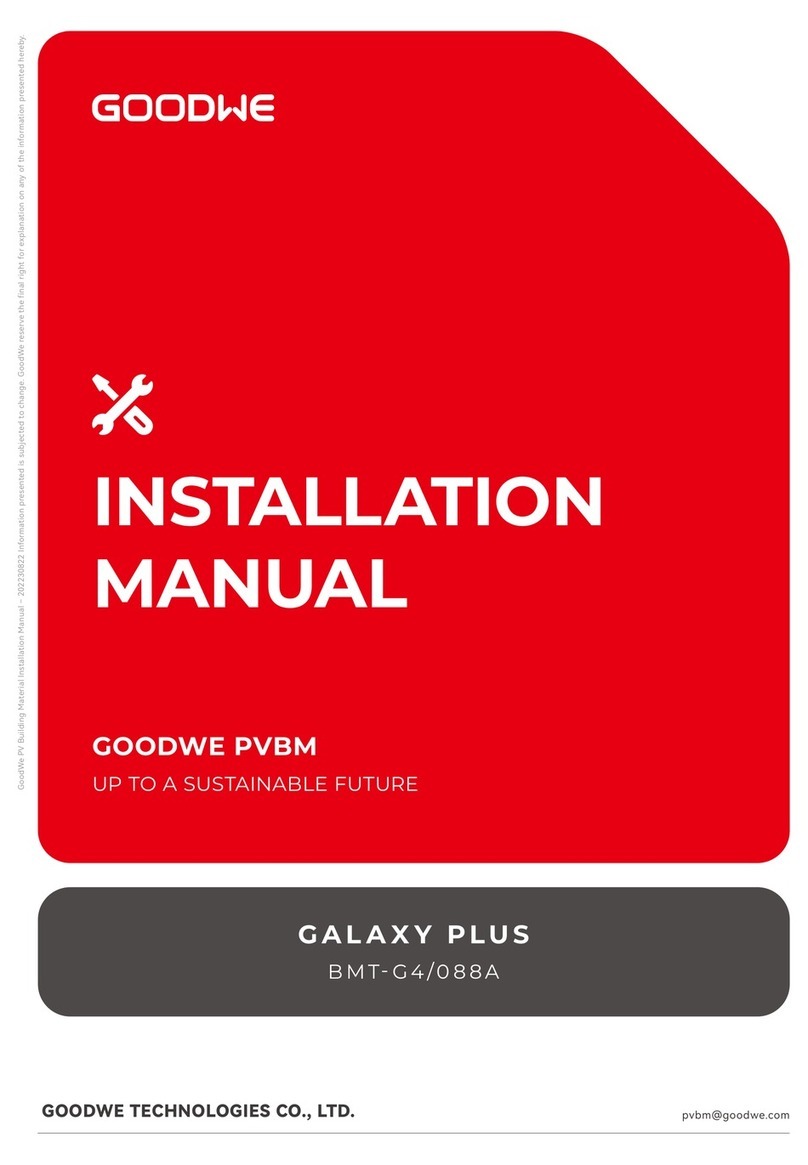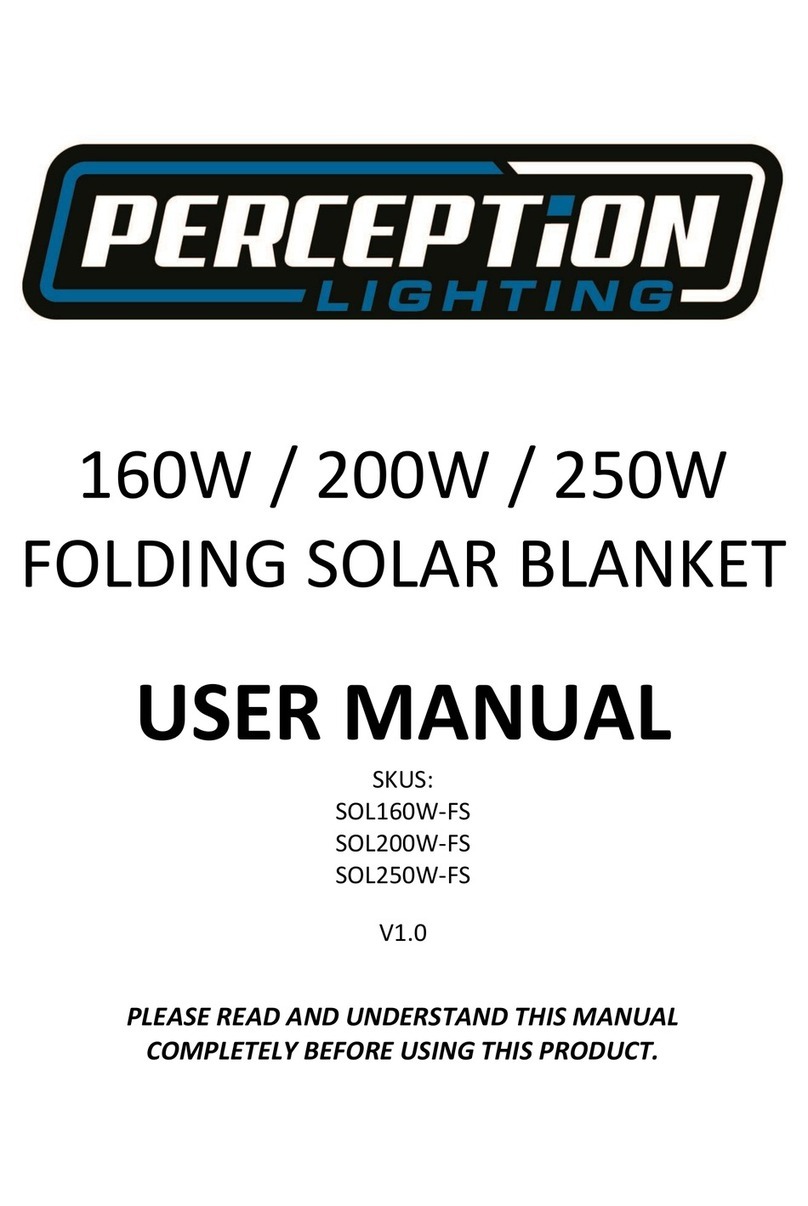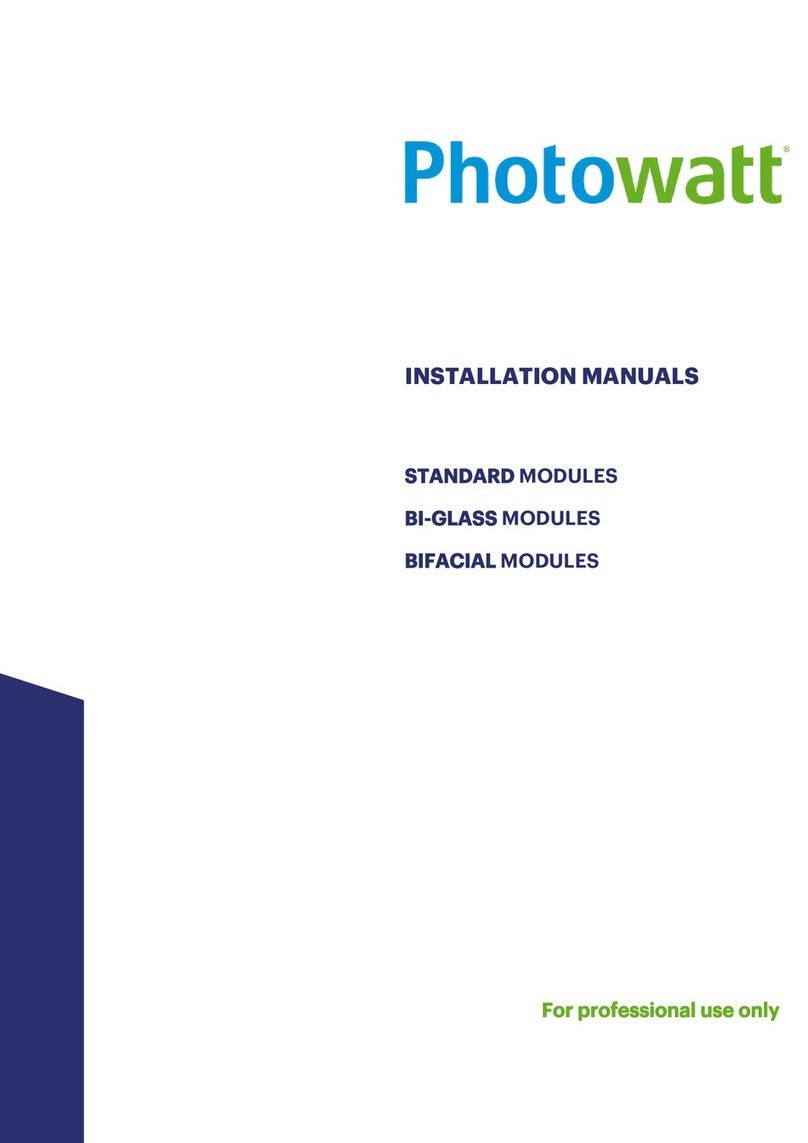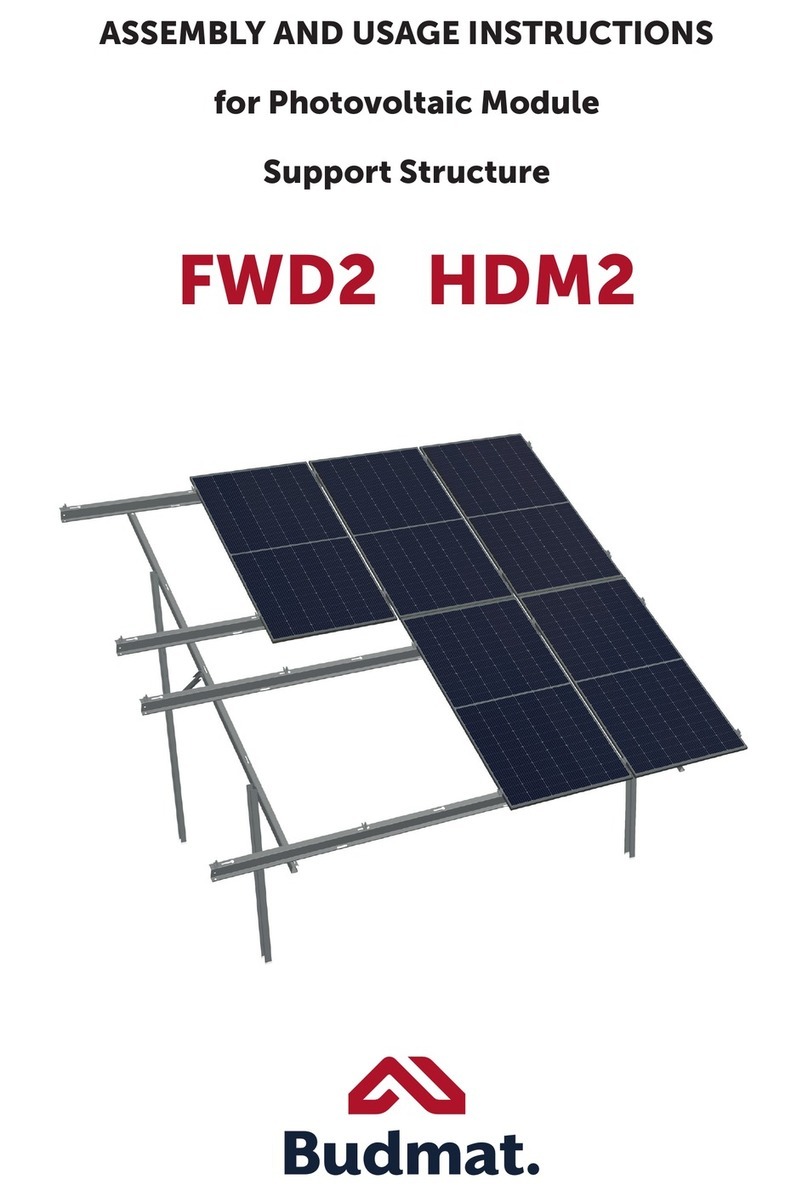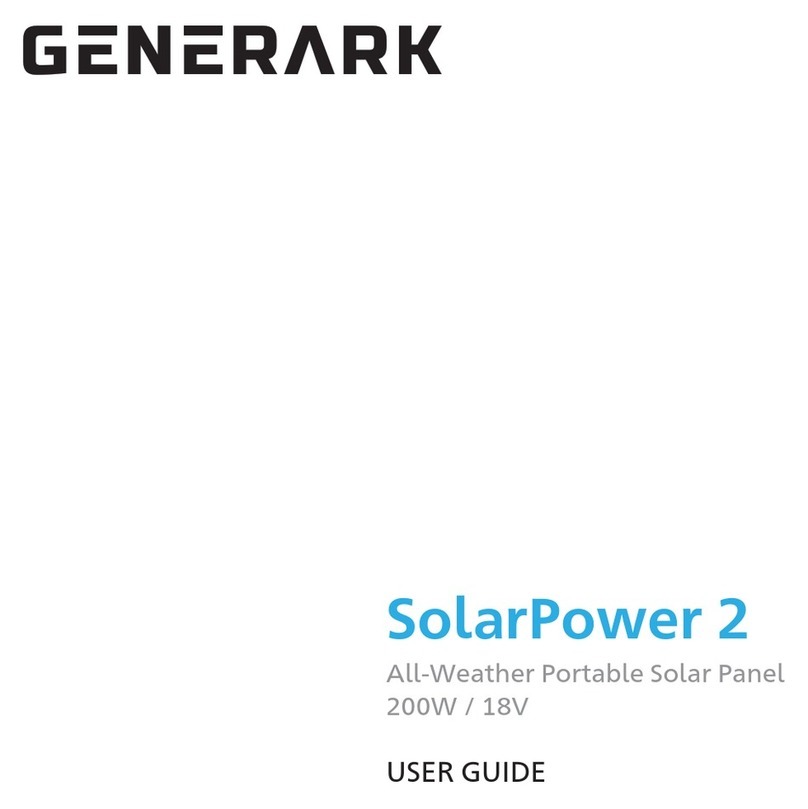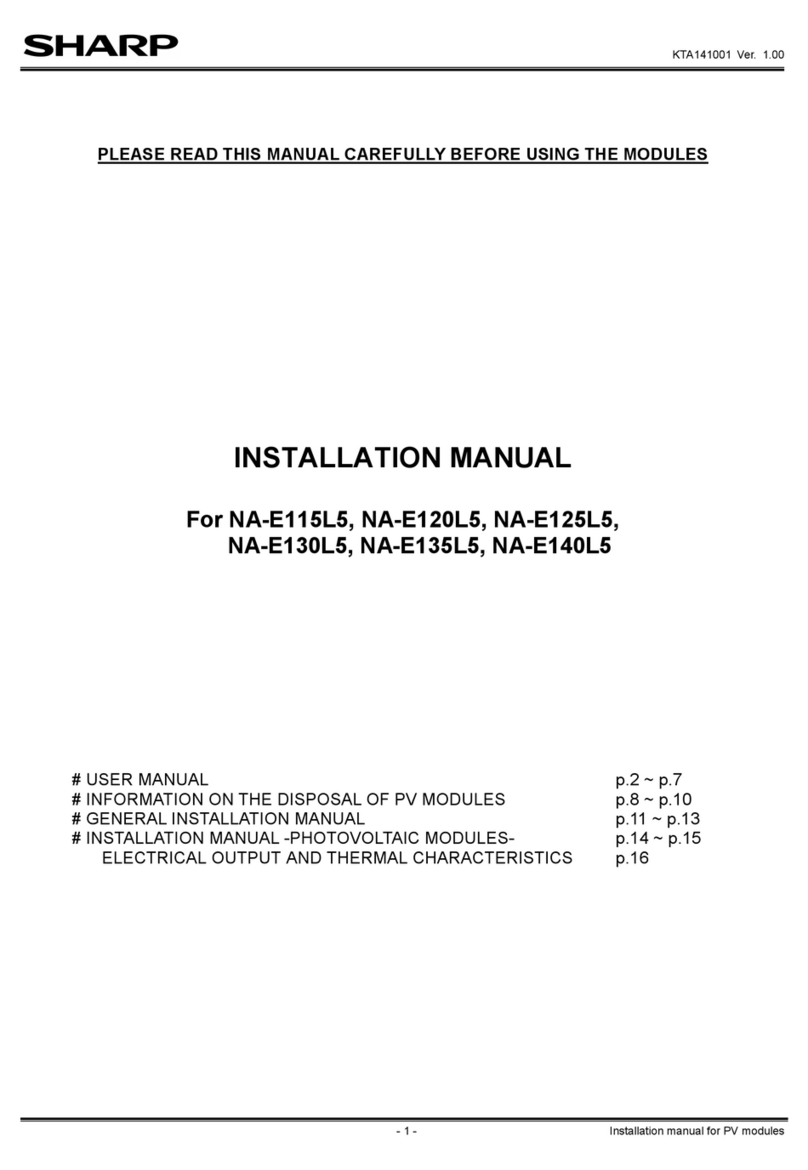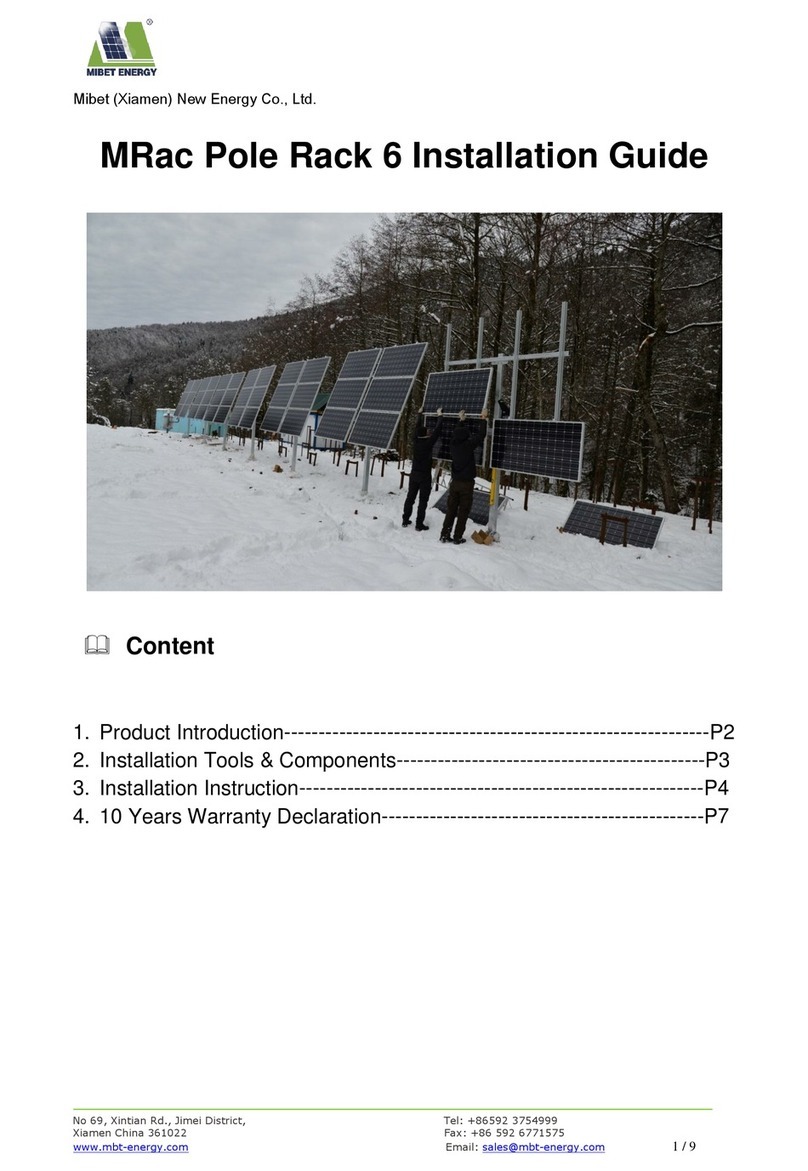Goodwe GALAXY Series User manual

INSTALLATION
MANUAL
GOODWE PVBM
SOLARIZE EVERY BUILDING
GALAXY SERIES
GOODWE AUSTRALIA PTY. LTD. sales.au@goodwe.com

Galaxy* Lightweight Products
Construction Manual
2022-06-14

GOODWE(GUANGDE)POWER SUPPLY TECHNOLOGY CO., LTD.
Page 1
Content
1、Description of the main structure of Galaxy* lightweight products..... 2
2、Installation materials list....................................................................................... 2
3、Installation tools list............................................................................................... 2
4、Pre-installation inspection work of Galaxy* lightweight products........ 3
5、Installation work of Galaxy* lightweight products...................................... 6
6、Electrical installation ............................................................................................13
7、Electrical construction Process.........................................................................18
8、Cautions ...................................................................................................................20
9、Appendix..................................................................................................................22

GOODWE(GUANGDE)POWER SUPPLY TECHNOLOGY CO., LTD.
Page 2
1、Description of the main structure of Galaxy* lightweight products
Galaxy* Lightweight Products Front
Installation Altitude: <2000m
Fire Protection Level:CLASS C
(IEC61730-2-MST23)
Protection Level:Level II
maximum static load: front 5400Pa; back 2400Pa
Coil material is made of thermoplastic TPO membrane.
2、Installation material list
Name
Neutral one-component silicone
Illustration
3、Installation tools list
3.1 Construction tools list
Coil material
(Thermoplastic TPO)
Junction
box

GOODWE(GUANGDE)POWER SUPPLY TECHNOLOGY CO., LTD.
Page 3
PS:This list only indicates the main tools required for the installation of Galaxy* Lightweight Products
structural system, excluding the tools used for the installation of the roof support section and the
electrical section.
For the tools of release and installation of roof brackets, you can refer to the preparation of building
works.
3.2 Electrical tools list
Tool name
Needle Nose
Plier
Wire cutter
Photovoltaic
special
crimping
pliers
Wire
stripping
pliers
Joint wrench
Illustration
4、Inspection work of Galaxy* lightweight products before installation
Warning
Please use insulated tools to reduce the risk of electric shock.
Please adopt appropriate protective measures (non-slip gloves, work clothes, etc.) to avoid
direct contact with 30V DC or higher, and avoid direct contact with sharp edges during
installation. Please do not wear metal ornaments during installation to avoid poking through
the Galaxy* lightweight products and causing electric shock hazards.
DO NOT install the product in rainy weather or strong wind.
DO NOT allow children or unauthorized personnel to approach the installation area or the
Tool
Name
Steel
tape
measure
Chalk Line
Utility Knife
Hot air welding
gun
Glue gun
Roller
Illustration

GOODWE(GUANGDE)POWER SUPPLY TECHNOLOGY CO., LTD.
Page 4
storage area of Galaxy* Lightweight products.
During installation or wiring of Galaxy* Lightweight products, if the circuit breaker and
overcurrent protection circuit breaker cannot be turned on or the inverter cannot be turned
off, then use an opaque material to cover the array Galaxy* Lightweight products to stop the
power output.
Do not use or install Galaxy* Lightweight products that have been damaged.
If the surface material is damaged or worn, direct contact with the surface of Galaxy*
lightweight products may result in electric shock.
Do not attempt to repair any part of the Galaxy* Lightweight product.
The lid of the junction box should be kept closed at all times.
Do not disassemble, modify, or move any part of the Galaxy* Lightweight product.
Do not artificially concentrate light on Galaxy* lightweight products.
It is important to note that only one piece of product can be moved in a single operation
when installing the Galaxy* products.
Installers are advised to consider additional hazards and local regulations relevant to the use
of a hot air weld gun including but not limited to welding at height, power cord management,
burns risks, restraint system management in the presence of a heat source, and consideration
for fumes and vapors, specifically:
Always lie the tool on a non-flammable surface & keep the hot air stream well away from
combustible materials, including combustible materials hidden behind ceilings, walls,
cavities or floors.
Do not point the hot air stream at the same spot for extended periods. Incorrect use can
cause fire.
Do not touch the element housing or nozzle with any part of the body during use as they
get very hot and there is a danger of serious injury by burning.
When working with plastics, varnish or similar materials vapors/gases/smoke develop
which can be harmful.

GOODWE(GUANGDE)POWER SUPPLY TECHNOLOGY CO., LTD.
Page 5
Do not breathe in vapors/gasses/smoke as they can be highly toxic.
Always provide good ventilation of the working area with an extraction system and/or
wear a respirator.
Keep the hot air welding unit dry. Do not use in the rain or in damp conditions. Always store the hot air
welding unit in a dry place.
Be careful
Before installing Galaxy* Lightweight products, the relevant authorities should be contacted
to obtain information about the installation site, construction permits or impact on roof
warranty, and the requirements for installation and inspection should be observed.
Check the applicable building codes to ensure that the building and its structure (roof,
exterior façade, load bearing, etc.) in which Galaxy* lightweight products are to be installed
have adequate load-bearing capacity.
Ensure that Galaxy* Lightweight products are installed on a fireproof roof, when installing
Galaxy* Lightweight products.
Galaxy* Lightweight products are compliant with Safety Class II. These Galaxy* Lightweight
products can be used in systems where the public is likely to be exposed to voltages greater
than 50V or power greater than 240W.
The installation surface should be flat and free of pits or bumps.
Galaxy* lightweight products must not be installed near flames or combustible objects.
Galaxy* lightweight products must not be immersed in water (pure or salt water), installed in
environments that are permanently wet (pure or salt water) (e.g. fountains, waves, etc.) or in
locations where water is likely to accumulate (e.g. potholes, drainage inlets, etc.).
There is a risk of corrosion if Galaxy* lightweight products are placed in salt spray (i.e., marine
environments) or environments containing sulfur (i.e., sulfur-containing sources, volcanoes,
etc.).
Ensure that Galaxy* Lightweight products meet the overall technical requirements of the

GOODWE(GUANGDE)POWER SUPPLY TECHNOLOGY CO., LTD.
Page 6
system.
Ensure that other system components do not cause damaging mechanical or electrical
performance effects on Galaxy* Lightweight products.
It is allowed to connect Galaxy* Lightweight products in series to increase the voltage or in
parallel to increase the current. When connected in series, the positive terminal of the Galaxy*
Lightweight product is connected to the next negative terminal. When connected in parallel,
the positive terminal of the Galaxy* Light product is connected to the positive terminal of the
next Galaxy* Light product.
To avoid (or minimize) the mismatch effect of the array, it is recommended to connect Galaxy*
Lightweight products with similar electrical properties on the same string.
To reduce the risk of indirect lightning strikes, the system should be designed to avoid the
creation of loops.
Galaxy* lightweight products should be securely fastened so that they can withstand all
possible loads, including wind and snow loads.
Secondary handling should be avoided as much as possible during the installation of Galaxy*
lightweight products.
Please ensure that the installation location of Galaxy* Lightweight products is free from
shading all year round, as shadows can cause a decrease in the power generation of Galaxy*
Lightweight products. Hot spots and long-term heat generation from diodes caused by
frequent shading of Galaxy* Lightweight products can affect the service life of Galaxy*
Lightweight products.
5、Installation work of Galaxy** lightweight products
5.1 Unpacking and stacking (storage and unpacking)
To ensure the safety of Galaxy* Lightweight products during transportation, it is better to
open the packaging box of Galaxy* Lightweight product after reaching the installation site.
Check whether the box is damaged before unpacking.
It is advised that unpackers wear non-slip gloves in advance.

GOODWE(GUANGDE)POWER SUPPLY TECHNOLOGY CO., LTD.
Page 7
Galaxy* lightweight products should be stored in a dry and ventilated environment.
Galaxy* Lightweight products must be shipped in the boxes provided by GoodWe and should
be stored in the original boxes before installation. Please protect the packaging from damage.
Follow the recommended unpacking procedure to open Galaxy* Lightweight product
packaging. Careful handling is required during unpacking, transportation and storage.
DO NOT apply excessive loads or twist Galaxy* Lightweight products.
DO NOT use wires or junction boxes to carry Galaxy* lightweight product.
DO NOT stand, climb, walk or jump on Galaxy* Lightweight products.
DO NOT to allow Galaxy* Lightweight products to come in contact with sharp objects;
scratches can directly affect the safety of Galaxy* Lightweight products.
DO NOT place Galaxy* lightweight products in an environment that is not reliably supported
or not fixed.
Changing the wiring of the bypass diode is prohibited.
All electrical connectors need to be kept clean and dry.
Galaxy* lightweight products are not allowed to be stacked flat and the quantity should not
exceed 3 pieces. The junction box shall not be in direct contact with the front side.
5.2 checking
Please check whether the surface of Galaxy* Lightweight products is damaged, if there is
damage or wear on the surface of the products, please do not use the product.
Please check whether the junction box, connectors and cables are damaged , please do not
use the product if there is damage.
Do NOT apply adhesives, paint, label or any other product on the surface of Galaxy*
Lightweight products.
5.3 Roof Substrate requirements
The base layer application scenario includes pitched metal roof and flat roof. and TPO rolls
need to be laid on the base layer.
The roof substrate needs to be covered with TPO material.

GOODWE(GUANGDE)POWER SUPPLY TECHNOLOGY CO., LTD.
Page 8
5.4 Chalk line Positioning
Measure the roof and determine the position of Galaxy* lightweight products according to
the design drawings.
5.5 Carrying
To avoid damaging the cells, two people are required to lift the four corners of the Galaxy*
Lightweight product (avoiding touching the position of the cells) at the same time when
carrying it.
The downward bending distance of Galaxy* lightweight products should not exceed 300mm.
Please carefully position Galaxy into predestined location.
Galaxy* lightweight products should be carried upright as much as possible when handled
manually. Do NOT twist the product during transportation.
Care is required during the handling of Galaxy* lightweight products to avoid them bumping
into the ground or other sharp, hard objects.
5.6 Installation
Note: all installation actions should in line with the requirements of the National Construction
Code
Metal roof with TPO membranes.
Apply structural adhesive to crests of TPO metal roof, with minimum spacing of 400mm.
Adhesive cross-section width ≥ 8mm, height ≥ 6mm.
Carry the product upright by grabbing the corners by two person
Place the product cell side up to the adhesive area (Figure 1)
Galaxy* Lightweight Products
Adhesive
Metal roof
Edge of product

GOODWE(GUANGDE)POWER SUPPLY TECHNOLOGY CO., LTD.
Page 9
Figure 1
Gently press the front of the product with a flexible tool so that the Galaxy* lightweight
product is firmly bonded to the crest of the metal roof.
Lift the coil of Galaxy* lightweight products slightly and use the hot air welding gun to spot
weld first to fix the Galaxy* lightweight products on the metal roof (as in Figure 2).
Figure 2
After fixing the head and tail of Galaxy* lightweight products, use hot air welding gun along
the coil for full welding. Use roller gently on the coil for roller pressure (such as Figure 3) when
welding to ensure that the coil is welded to flat roof. The effective welding width of the coil ≥
25mm, the effective welding area of the coil needs to cover in the color steel tile crest or crest
slope, if the welding area covers in the color steel tile valley area, it needs to be filled in the
valley so that the product is flush along the roof with the crest for effective welding (such as
Figure 4, Figure 5).
Figure 3
Hot air welding gun
Roller
Coil material
Hot air welding gun
Spot welding
Coil material
Galaxy* lightweight
product
Galaxy* Lightweight Products
Color Steel Tile
Color Steel Tile

GOODWE(GUANGDE)POWER SUPPLY TECHNOLOGY CO., LTD.
Page 10
Figure 4
Figure 5
The distance between two adjacent Galaxy* lightweight products is 30±10mm. A 300mm
construction access channel is reserved between two rows of Galaxy* lightweight products on
the junction box side. A 170mm construction access should be reserved on the tail side of the
product. (Figure 6).
Figure 6
Coil material
Color steel tile crest
Galaxy** lightweight product
≥25mm
≥25mm
Color steel tile crest
Color steel tile valley
Color steel tile valley
300mm
≥300mm
170mm
30mm
Galaxy* Lightweight Products
Valley filling
Valley filling
Color steel tile crest
slope
Color steel tile crest slope

GOODWE(GUANGDE)POWER SUPPLY TECHNOLOGY CO., LTD.
Page 11
TPO flat roofing installation form:
Mark the position of the array.
Apply structural adhesive to the EPDM strips on the back side of the product with a
cross-sectional width of at least 8 mm and height of at least 6 mm.
Two people grip the four corners of Galaxy* Lightweight product, carry them vertically, and
then face up to bond the adhesive strip on the back of the products to the flat roof.. Use a
flexible tool to gently press the front of the product to fully bond the product to the roof (as in
Figure 7).
Figure 7
Lift the Galaxy* lightweight product slightly at both ends of the coil and use a hot air torch to
spot weld first to fix the product to the roof (as in Figure 8).
Figure 8
After fixing the head and coil of the Galaxy* lightweight products, use the hot air welding gun
along the coil for full welding. Use rollers gently on the coil roll pressure when welding (as
Figure 9) to ensure that the coil secured to flat roofing. The effective welding width of the
head and tail coil should be at least 25mm (such as Figure 10, such as Figure 11).
Coil material
Hot air weld gun
Spot welding
Galaxy*
Lightweight
Products
Galaxy* Lightweight
Products
Adhesive strip
Silicone
Silicone

GOODWE(GUANGDE)POWER SUPPLY TECHNOLOGY CO., LTD.
Page 12
Figure 9
Figure 10
Fgure 11
The distance between two adjacent Galaxy* lightweight products is 30±10mm. A 300mm
construction access channel is reserved between two rows of Galaxy* lightweight products on
the junction box side. A 170mm construction access should be reserved on the tail side of the
product. (Figure 12).
Hot air weld gun
roller
Coil
material
Galaxy*
lightweight
products
≥25mm
≥25mm

GOODWE(GUANGDE)POWER SUPPLY TECHNOLOGY CO., LTD.
Page 13
Figure 12
6、Electrical installation
6.1 Electrical performance
The nominal values of electrical performance parameters such as Isc, Voc and Pmax of Galaxy*
Lightweight products have an error of ±3% from those under standard test conditions. Standard test
conditions for Galaxy* Lightweight products: irradiance 1000 W/m2, cell temperature 25°C, atmospheric
mass AM 1.5. When Galaxy* Lightweight products are connected in series, the total voltage is the sum of
voltage of every single Galaxy* Lightweight products in the string, and when Galaxy* Lightweight
products are connected in parallel, the final current is the sum of the current of every string of Galaxy*
Lightweight products, as shown in Figure 6-1. Galaxy* Lightweight products of different electrical
performance models should not be connected in one string.
Figure 6-1 Series-parallel electrical diagram
The maximum number of single strings of Galaxy* Lightweight products that can be connected in series
must be calculated in accordance with the requirements of local electrical requirements and regulations.
and the value of its open-circuit voltage at the lowest expected local temperature conditions must not
300mm
≥300mm
170mm
30mm

GOODWE(GUANGDE)POWER SUPPLY TECHNOLOGY CO., LTD.
Page 14
exceed the maximum system voltage value specified for Galaxy* Lightweight products (maximum
system voltage for the products is DC1000V/DC1500V - the actual system voltage is designed
according to the selection of the product models and inverters) and other values required for DC
electrical components.
The open circuit voltage correction factor can be calculated with following formula:
CVoc=1-βVoc×(25-T) where T is the minimum ambient temperature expected at the system installation
location and β(%/°C) is the temperature coefficient of the open circuit voltage of selected Galaxy*
Lightweight product(refer to the corresponding Galaxy* Lightweight product parameter table).
If a reverse current exceeding the maximum fuse current of the Galaxy* Lightweight product may pass
through the Galaxy* Lightweight product, an overcurrent protection device of the same size must be
used to protect the product. If the number of parallel connections is more than or equal to 2 strings,
there must be an overcurrent protection device on each string of the products, as shown in the figure
6-1.
6.2 Cable and Connecting Wires
Galaxy* Lightweight products shall be connected by using IP67 rated junction boxes, which shall
provide safe protection for the conductors and their corresponding connections, and accessible
protection for non-insulated live parts. The junction box consists of a connected cable and IP67 rated
connectors to facilitate series connection between Galaxy* Lightweight products. A single product has
two separate wires connected to two separate junction boxes, one positive and one negative. Two
Galaxy* Lightweight products can be connected in series by inserting the positive connector into the
socket of the negative connector of the adjacent product.
Use dedicated solar cables and appropriate connectors (wires should be encased in age-resistant
conduit or, if exposed to air, should be age-resistant themselves) and ensure that the cables are
electrically and mechanically sound, in accordance with local fire, building and electrical codes.
Installers should only use single-core solar cables, 2.5-16mm2 (5-14 AWG), 90°C rated, with appropriate
insulation to withstand the maximum possible system open circuit voltage (as approved by EN 50618).
Appropriate wire sizes need to be selected to minimize voltage drop. All wiring and electrical

GOODWE(GUANGDE)POWER SUPPLY TECHNOLOGY CO., LTD.
Page 15
connections comply with the requirements of the appropriate National Electrical Code or standard.
Avoid mechanical damage to the cable or Galaxy* lightweight products when the cable is secured to the
bracket. Do not press the cable with force. The cable shall be secured to the bracket by specially
designed aging resistant cable ties and wire clips. Although the cable is resistant to aging and water, it
should be protected from direct sunlight and rain. The minimum bending radius of the cable should be
43mm.
Figure 6-2 Minimum bending radius of the cable
6.3 Connector
Please keep the connector dry and clean, and make sure that the nut of the connector is tightened
before connecting. Do not connect the connector when it is wet, dirty or in other unfavorable condition.
If the connector is not connected properly to the other polarity, the connector is not waterproof. It is
necessary to connect or take appropriate measures to avoid the infiltration of water vapor and dust as
soon as possible after the module is mechanically installed to the roof. Avoid having connectors being
exposed to direct sunlight and immersed in water. Avoid having connectors falling on the ground or on
the roof. Incorrect connections may produce arcing and electric shock. Make sure all electrical
connections are secure. Make sure that all connectors with locking are fully connected.
It is not recommended that connectors of different models be connected and used together.
6.4 Bypass Diode
The cell strings within a solar module are protected by bypass diodes in parallel and encapsulated in a
junction box. When a hot spot phenomenon occurs locally in a module, the diode will activate so that
string current no longer flows from the hot spot cells, thus limiting module heating and performance
loss. Note that the bypass diode is not an overcurrent protection device. Contact the installer or system

GOODWE(GUANGDE)POWER SUPPLY TECHNOLOGY CO., LTD.
Page 16
maintainer when a diode failure is detected or suspected. Do not attempt to open the module's junction
box by yourself.
6.5 Electrical requirements for the installation of Galaxy*lightweight products
1、Inspection before installation
①No visible defects.
②Models and specifications should meet the requirements of the design drawings.
③Accessories and spare parts are available;
④For electrical parameters, please refer to the appendix product specification.
2、Preparation of main tools
①Multimeter: For measuring the open-circuit voltage of Galaxy* lightweight products.
②Angle measuring instrument, level, etc.: measuring the installation angle of the Galaxy* lightweight
product array.
③Installation tools and spare parts covered in Section 4.
6.6 Material Preparation
Please check whether the type and quantity of the arriving material is correct against the material list in
configuration sheet.
1、Galaxy* Lightweight Products Electrical Wiring Requirements
①Wiring with clear, unambiguous and easily understood wire number identification.
②Jumper cable diameter must be exceed the original Galaxy* lightweight product cable diameter, and
flame retardant and insulation performance should also be no less than that of Galaxy* lightweight
product cable.
③Galaxy* lightweight products should be connected to each other in the shortest cable run possible.
When Galaxy* lightweight products require long straddle connections, try to minimize the difference in
the total length of each set of string-connected cables.
④The wiring terminals should be in good contact. When connecting each part of the Galaxy*
lightweight product in series, it is best to test once each section is completed with a multimeter to
string connectivity.

GOODWE(GUANGDE)POWER SUPPLY TECHNOLOGY CO., LTD.
Page 17
2、Electrical wiring method of Galaxy* lightweight products
① Wiring in accordance with the wiring in the electrical schematic.
② For products connected in series, the "+" pole of one product is connected to the "-" pole of another
product. Extension cables are required if connection of products between different rows is needed.
Please use entension cables that are for solar application specifically.
Figure 6-3 Product jumper connection operation instructions (front view)
③ When a group of series connections are connected as shown in the drawing, the remaining group of
"+" and "-" pole terminals are connected to the combiner connector or combiner box.
④ Parallel connection of all accessory strings are done at the combiner connector or combiner box.
Note: This document only describes the wiring requirements and wiring principles. Since the roof
of each site may not be the same, it is not possible to make uniform wiring process for each project
here. Wiring can be done later in accordance with the product installation layout drawings in each
project.
6.7 Combiner box installation requirements
① Connect the combiner kit to the product array according to the electrical schematic.
② Docking plugs to be plugged in place and firmly connected.
③ The combiner kit can be fixed on the bracket, the alignment is neat and easy to maintain.
④ The connection of the cable should avoid cable stress and friction due to wind-blown vibration and
damage to the outer skin of the cable.

GOODWE(GUANGDE)POWER SUPPLY TECHNOLOGY CO., LTD.
Page 18
⑤ After the terminals of the combiner kit are connected, use the same cable clamps as the terminals of
the product to clamp up the ends of the terminals.
7、Electrical construction process
In Australia, electrical installations should be installed in accordance to AS/NZS 3000 and AS/NZS 5033.
7.1 Construction Process
7.1.1 Operating conditions
① Assembly of product array is completed.
② Installation of inverter and distribution box is completed.
7.1.2 Preparation of main tools
① Impact drill: For drilling holes in the installation position of PVC and other line pipes and pipe
cards.
②MC4 crimper: For on-site DC cable MC4 splice plug production.
③ Multimeter, megohmmeter: For cable conduction and insulation testing.
Wire stripping pliers: for cable stripping.
7.1.3 Main Materials
①DC cables for photovoltaics.
②AC cables.
③Cable DC connectors use the same type of MC4 as the product or a compatible one.
7.1.4 Installation Engineering Process
①Determine the cable run and AC/DC conduit requirement after on-site measurement.
② Conduit is required for cables between array and inverter. Conduit is required for cables
between inverter and distribution box, distribution box and household electricity box.
7.1.5 Conduit laying requirements
① Follow local electrical standards and regulations when designing and laying the conduits,
requirements of local standards and regulations prevails if contradictions is found.
When laying electrical conduits on the wall, they should be laid in the corners of the wall, in the same
direction along rainfall pipes and air-conditioning pipes.
Other manuals for GALAXY Series
2
This manual suits for next models
5
Table of contents
Other Goodwe Solar Panel manuals
Popular Solar Panel manuals by other brands

Panasonic
Panasonic HIT VBHN SJ53 Series General installation manual
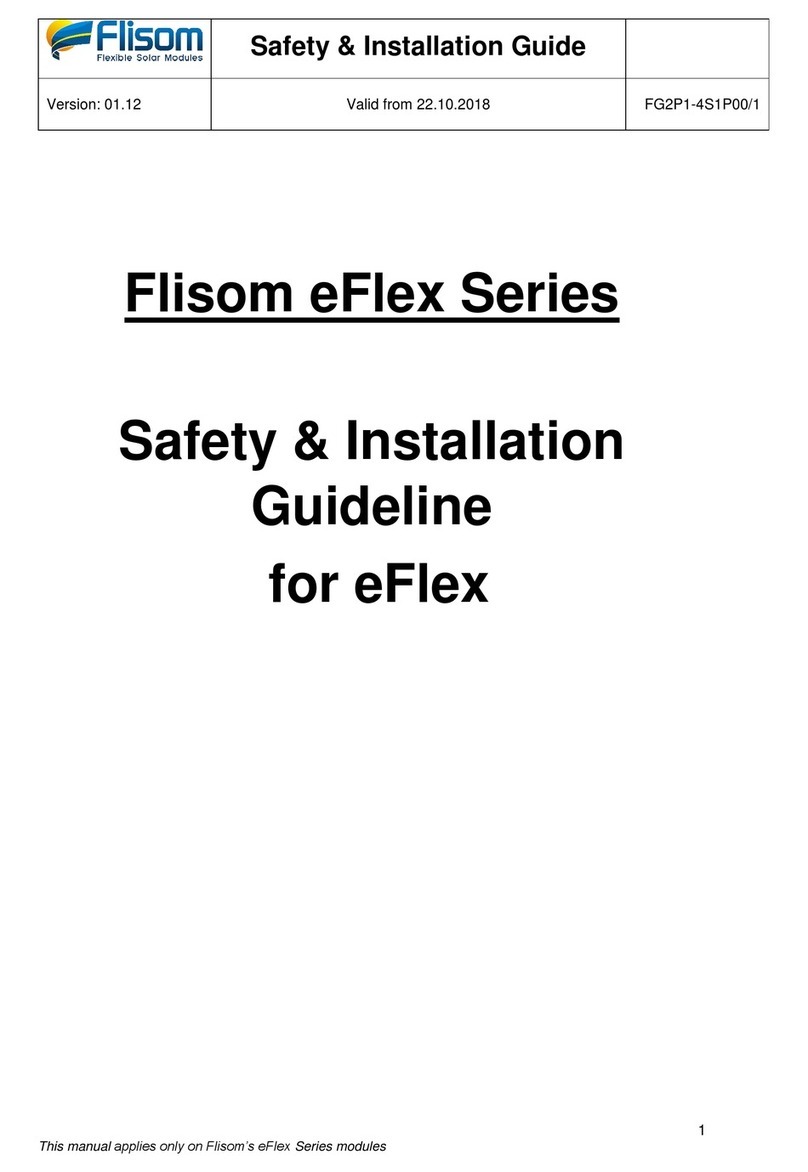
Flisom
Flisom eFlex Series Safety and installation guide

Viessmann
Viessmann VITOSOL-F Service instructions
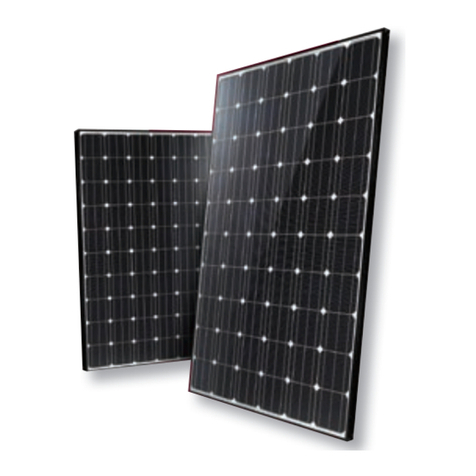
LG
LG LG240M1C installation instructions
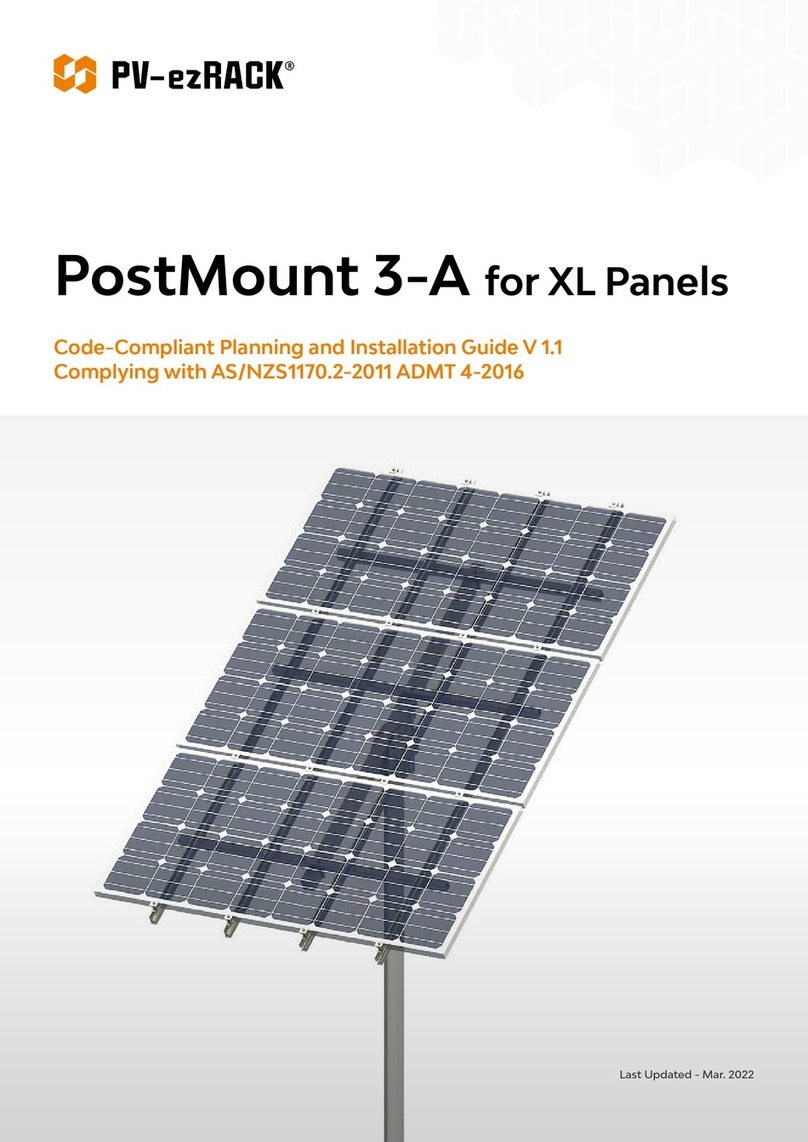
PV-ezRack
PV-ezRack PostMount 3-A Code-Compliant Planning and Installation Guide

REC
REC ALPHA Series installation instructions
